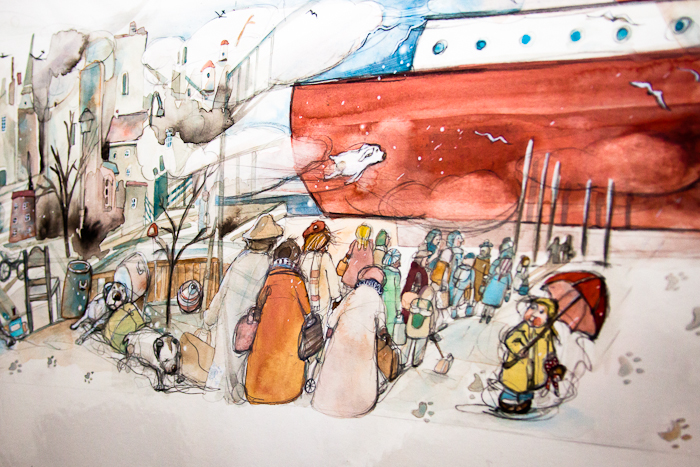Australian picture books: Humanising and thoughtful depictions of displaced children

My Two Blankets by Irena Kobald & Freya Blackwood was selected for the ‘Read for Australia’ event on Friday 2 September 2016 where school students around the country read the same book as part of National Literacy and Numeracy Week. My Two Blankets tells the story of a young girl who is making a new home in Australia and focuses on her experiences of learning an additional language.
Through this wonderfully written and illustrated book that is both for children and about children, we are prompted to think carefully about critical issues that dominate the world globally and locally. Taking the time to read this picture book provides an excellent opportunity to consider impacts of war, forced movement of people and experiences of resettlement from a child’s perspective.
My Two Blankets is not the only picture book that should be read by children and adults alike – there are many others by Australian authors that focus on the impacts of war and displacement on children’s lives. They include: The Little Refugee (2011) by Anh Do, Suzanne Do & Bruce Whatley, Ships in the Field (2012) by Susanne Gervay & Anna Pignataro, My Dog (2000) by John Heffernan & Andrew McLean; Ziba Came on a Boat (2007) by Liz Lofthouse & Robert Ingpen, Dancing the Boom-Cha-Cha Boogie (2005) by Narelle Oliver; A Safe Place to Live (2011) by Bic Walker, The Treasure Box (2013) by Margaret Wild & Freya Blackwood, Home and Away (2008) by John Marsden & Matt Ottley; and Teacup (2015) by Rebecca Young & Matt Ottley.
In terms of public debate about people seeking asylum – images are often used in newspapers in a straightforward illustrative manner – for example to ‘prove’ people threw their children overboard (as discussed by scholars including Jane Lydon). In picture books, it’s the interplay between words and images where meaning is made. The significance of telling stories about refugees and displaced children though the genre of picture books is that they entice readers of all ages to look carefully at the images and text, to have conversations about them and consider stories and experiences that are often publicly presented in an antagonistic manner.
Researchers at the University of Queensland have examined national newspaper front pages that depict asylum seekers and found dehumanising patterns which they argue define the possibilities of any political discussion. The images and stories in picture books are created for difference audiences than newspaper front pages, but they are significant public representations too. In picture books we see greater possibilities for discussion and humanising patterns which are vital for us to have and share.
One case which demonstrate this possibility in detail can be seen in Susanne Gervay and Anna Pignataro’s Ships in the Field. It is a prime example that conveys the effects of war, displacement and dislocation on a little girl and her family by drawing on the family histories and experiences of both the author and illustrator.
The story is of a little girl who now lives with her mother and father in what could be Australia. The little girl navigates life with her toy dog Brownie. She wants a real dog too. She draws a picture of a dog and shows her Papa. He says ‘One day you will have a real dog’. We learn her Ma ‘had a dog. In the old country. Before there was war.’ A little white dog appears in an almost ghost like-presence on this page. Anna Pignataro has written about her parents being expelled from their home in Egypt and having to leave a pet dog in Italy before migrating to Australia.
In the story, a double page without any written text follows, we see people heading towards a ship in the war-torn ‘old country’ and a dog, moving through the images. The image of ships continues in the text, with additional layers of written language.
The story carries on, on Sundays the girl and her parents go picnicking in the country. On a trip there is the following exchange: “‘Look at the ships in the field,’ Papa says.” The image accompanying the written text is of sheep in the field, and is merged with people leaving the war-torn ‘old country’ by train and boat. The girl’s parents are in the foreground.
The dialogue continues on the next page.
Brownie and I giggle. ‘Papa, you mean sheep.’
‘Yes, the ships.’ Papa wiggles his moustache.
Brownie looks at me sadly. He hates it when other people laugh at the way Papa talks.
I hate it too. Ma says nothing.
I hug Brownie and then start to sing.
‘Baa, baa, black ships. Have you any wool?’
The four of them sing the song together.
The interplay here between the written language and the illustrations is layered with meaning of ships and sheep. A complex story is told in which the girl and Brownie can giggle at her father’s language but also understand it as making his difference and something that is derided by others. Susanne Gervay has spoken about this occurring and her father’s ‘Hunglish’ (The Sun-Herald, 26 February 2012, p6).. In the story, the girl and her dog choose ship, rather than sheep when singing the nursery rhyme. They refuse linguistic assimilation of the new world and choose, in this moment, to be like Papa. With this example, and others too, the words and images in picture books convey lived histories of displacement and loss.
Reading and sharing stories matters for all of us, as stories are an important way in which collectively we can think about issues, ideas and values that are important. The key significance of having My Two Blankets as part of a shared nationwide reading experience is that it creates opportunities for us all to think carefully about the impact of war and displacement on children’s lives as well as how we publicly talk about these issues.
[…] Originally posted here. […]